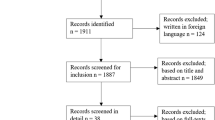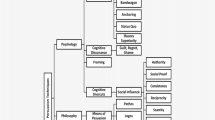Abstract
The current study differs from previous research that measured WOM activity, as an experimental between-subjects research design, was applied and the stimuli were videos of four service encounters to ensure external validity. The factors that were manipulated in the experiment were the level of service quality provided by the waitron and the waitron’s emotional display. The study found that WOM activity measurement by means of a typical recommendation item is not a true reflection of how a customer experienced a service encounter and more recommendations were done personally than by electronic means. Managerial implications, based on the findings, are made.
Similar content being viewed by others
References
Albrecht K, Zemke R (1985) Service America! Doing business in the new economy. Dow Jones-Irwin, Homewood
American Customer Satisfaction Index (2001) Methodology report. The Regents of the University of Michigan, Ann Arbor
Anderson EW (1998) Customer satisfaction and word of mouth. J Serv Res 1(1):5–17. doi:10.1177/109467059800100102
Bitner MJ (1990) Evaluating service encounters: the effects of physical surroundings and employee responses. J Mark 54(2):69–82
Brown TJ, Barry TE, Dacin PA, Gunst RF (2005) Spreading the word: investigating antecedents of consumers’ positive word-of-mouth intentions and behaviors in a retailing context. J Acad Mark Sci 33(2):123–138. doi:10.1177/0092070304268417
Cheema A, Kaikati AM (2010) The effect of need for uniqueness on word of mouth. J Mark Res 47(3):553–563. doi:10.1509/jmkr.47.3.553
Chevalier JA, Mayzlin D (2006) The effect of word of mouth on sales: online book reviews. J Mark Res 43(3):345–354. doi:10.1509/jmkr.43.3.345
Christiansen T, Tax SS (2000) Measuring word of mouth: the questions of who and when? J Mark Commun 6(3):185–199. doi:10.1080/13527260050118676
Cowley E (2014) Consumers telling consumption stories. J Bus Res 67(7):1522–1529. doi:10.1016/j.jbusres.2014.01.013
Czepiel JA, Solomon MR, Surprenant CF (1985) The service encounter. Lexington Books, Lexington
De Matos CA, Rossi CAV (2008) Word-of-mouth communications in marketing: a meta-analytic review of the antecedents and moderators. J Acad Mark Sci 36(4):578–596. doi:10.1007/s11747-008-0121-1
Deighton J (1992) The consumption of performance. J Consum Res 19(3):362–372
Delgadillo Y, Escalas JE (2004) Narrative word-of-mouth communication: exploring memory and attitude effects of consumer storytelling. Adv Consum Res 31:186–192
Diefendorff JM, Richard EM (2003) Antecedents and consequences of emotional display rule perceptions. J Appl Psychol 88(2):284–294. doi:10.1037/0021-9010.88.2.284
Duan W, Gu B, Whinston BA (2008) The dynamics of online word-of-mouth and product sales: an empirical investigation of the movie industry. J Retail 84(2):233–242. doi:10.1016/j.jretai.2008.04.005
East R, Hammond K, Lomax W, Robinson H (2005) What is the effect of a recommendation? Mark Rev 5(2):145–157
East R, Hammond K, Lomax W (2008) Measuring the impact of positive and negative word of mouth on brand purchase probability. Int J Res Mark 25(3):215–224. doi:10.1016/j.ijresmar.2008.04.001
Escalas JE (2004) Narrative processing: building consumer connections to brands. J Consum Psychol 14(2):168–180
Godes D, Mayzlin D, Chen Y, Das S, Dellarocas C, Pfeiffer B, Libai B, Sen S, Shi M, Verlegh P (2005) The firm’s management of social interactions. Mark Lett 16(3):415–428
Grandey A, Fisk G, Mattila A, Jansen KJ, Sideman L (2005) Is service with a smile enough? Authenticity of positive displays during service encounters. Organ Behav Hum Decis Process 96(1):38–55. doi:10.1016/j.obhdp.2004.08.002
Gremler DD, Brown SW (1994) Word-of-mouth communication and customer loyalty to service providers. In: Proceedings of the AMA summer educators’ conference: enhancing knowledge development in marketing
Grönroos C (1990) Service management and marketing. Lexington Books, Lexington
Grougiou V, Pettigrew S (2011) Senior customers’ service encounter preferences. J Serv Res 14(4):475–488. doi:10.1177/1094670511423785
Grove SJ, Fisk RP (1989) Impression management in services marketing: a dramaturgical perspective. In: Giacalone RA, Rosenfeld P (eds) Impression management in the organization. Erlbaum, Hillsdale NJ, pp 427–438
Gruen TW, Osmonbekov T, Czaplewski AJ (2006) eWOM: the impact of customer-to-customer online know-how exchange on customer value and loyalty. J Bus Res 59(4):449–456. doi:10.1016/j.jbusres.2005.10.004
Harrison-Walker LJ (2001) The measurement of word-of-mouth communication and an investigation of service quality and customer commitment as potential antecedents. J Serv Res 4(1):60–75. doi:10.1177/109467050141006
Hennig-Thurau T, Groth M, Paul M, Gremler DD (2006) Are all smiles created equal? How employee-customer emotional contagion and emotional labor affect service relationships. J Mark 70(3):58–73
Hogan JE, Lemon KN, Libai B (2004) Quantifying the ripple: word of mouth and advertising effectiveness. J Adv Res 44(3):271–280. doi:10.1017/S0021849904040243
Hosany S, Martin D (2012) Self-image congruence in consumer behavior. J Bus Res 65(5):685–691. doi:10.1016/j.jbusres.2011.03.015
Hu N, Liu L, Zhang JJ (2008) Do online reviews affect product sales? The role of reviewer characteristics and temporal effects. Inf Technol Manag 9(3):201–214. doi:10.1007/s10799-008-0041-2
Karande K, Magnini VP, Tam L (2007) Recovery voice and satisfaction after service failure: an experimental investigation of mediating and moderating factors. J Serv Res 10(2):187–203. doi:10.1177/1094670507309607
Laurence J (2007) Writing crime fiction. Studymates, Plymouth
Lee EJ, Schumann DW (2004) Explaining the special case of incongruity in advertising: combining classic theoretical approaches. Mark Theory 4(1/2):59–90. doi:10.1177/1470593104044087
Macintosh G, Lockshin LS (1997) Retail relationships and store loyalty: a multi-level perspective. Int J Res Mark 14(5):487–497
Mattila A, Enz C (2002) The role of emotions in service encounters. J Serv Res 4(4):268–277. doi:10.1177/1094670502004004004
McDougall GHG, Levesque T (2000) Customer satisfaction with services: putting perceived value into the equation. J Serv Mark 14(5):392–410. doi:10.1108/08876040010340937
Morris JA, Feldman DC (1996) The dimensions antecedents and consequences of emotional labor. Acad Manag Rev 21(4):986–1010
Murray KB, Schlachter JL (1990) The impact of services versus goods on consumers’ assessment of perceived risk and variability. J Acad Mark Sci 18(1):51–65
Nguyen C, Romaniuk J (2010) The accuracy in word of mouth valence classification: coder versus respondents. In: Proceedings of the 2010 ANZMAC conference
Price LK, Arnould EJ, Deibler SL (1995) Consumers’ emotional responses to service encounters: the influence of the service provider. Int J Serv Ind Manag 6(3):34–63
Pugh SD (2001) Service with a smile: emotional contagion in the service encounter. Acad Manag J 44(5):1018–1027
Sánchez-Hernández RM, Martínez-Tur V, Peiró JM, Moliner C (2010) Linking functional and relational service quality to customer satisfaction and loyalty: differences between men and women. Psychol Rep 106(2):598–610. doi:10.2466/PR0.106.2.598-610
Schellekens G, Gaby A, Verlegh JPW, Smidts ALE (2010) Language abstraction in word of mouth. J Consum Res 37(2):207–223. doi:10.1086/651240
Senecal S, Nantel J (2004) The influence of online product recommendations on consumers’ online choices. J Retail 80(2):159–169. doi:10.1016/j.jretai.2004.04.001
Sheth N, Mittal B, Newman I (1999) Consumer behavior and beyond. Dryden Press, Fort Worth
Sirohi N, McLaughlin EW, Wittink DR (1998) A model of consumer perceptions and store loyalty intentions for a supermarket retailer. J Retail 74(2):223–245
Söderlund M, Mattsson J (2009) Measuring word-of-mouth activity with recommendation items in service research: what is captured and what is lost? In: Proceedings of the 2009 ANZMAC conference
Söderlund M, Rosengren S (2010) The happy versus unhappy service worker in the service encounter: assessing the impact on customer satisfaction. J Retail Consum Serv 17(2):161–169. doi:10.1016/j.jretconser.2010.01.001
Sweeney JC, Soutar GN, Mazzarol T (2008) Factors influencing word of mouth effectiveness: receiver perspectives. Euro J Mark 42(3/4):344–364. doi:10.1108/03090560810852977
Tsai W-C, Huang Y-M (2002) Mechanisms linking employee affective delivery and customer behavioral intentions. J Appl Psychol 87(5):1001–1008. doi:10.1037//0021-9010.87.5.1001
Wangenheim FV, Bayón T (2007) The chain from customer satisfaction via word-of-mouth referrals to new customer acquisition. J Acad Mark Sci 35(2):233–249. doi:10.1007/s11747-007-0037-1
Westbrook RA (1987) Product/consumption based affective responses and postpurchase processes. J Mark Res 24(3):258–270
Wharton AS, Erickson RJ (1993) Managing emotions on the job and at home: understanding the consequences of multiple emotional roles. Acad Manag Rev 18(3):457–486
Xia L, Bechwati NN (2008) Word of mouse: the role of cognitive personalization in online consumer reviews. J Interact Advert 9(1):3–13. doi:10.1080/15252019.2008.10722143
Zeithaml VA (1981) How consumer evaluation processes differ between goods and services. In: Donnelly JH, George WR (eds) Marketing of services. American Marketing Association, Chicago, pp 186–190
Zeithaml VA, Bitner MJ (1996) Services marketing. McGraw-Hill, New York
Zeithaml VA, Berry LL, Parasuraman A (1993) The nature and determinants of customer expectations of service. J Acad Mark Sci 21(1):1–12
Author information
Authors and Affiliations
Corresponding author
Rights and permissions
About this article
Cite this article
Terblanche, N.S. Measuring word-of-mouth activity after a service encounter: are we measuring what customers communicate?. Serv Bus 10, 283–299 (2016). https://doi.org/10.1007/s11628-015-0268-z
Received:
Accepted:
Published:
Issue Date:
DOI: https://doi.org/10.1007/s11628-015-0268-z




